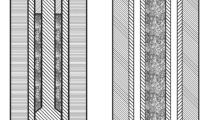Abstract
Shock compression of Ti–C and Zn–S mixtures and the corresponding compounds in cylindrical shock‐recovery capsules was studied under identical experimental conditions. In reactive systems, the spall plates have larger dimensions than in inert mixtures, which is attributed to the effect of exothermic reactions of shock‐wave synthesis on the intensity of the bow wave. Energy estimates were obtained for the degree of chemical conversion in shock waves.
Similar content being viewed by others
REFERENCES
S. S. Batsanov, G. S. Dorornin, S. V. Klochkov, and A. I. Teut, “Synthesis reactions behind shock fronts,” Combust. Expl. Shock Waves, 22, No. 6, 765–768 (1986).
S. S. Batsanov, M. F. Gogulya, M. A. Brazhnikov, et al., “Shock compression of reactants in the tin–chalcogen system,” Khim. Fiz., 10, 1699–1704 (1991).
S. S. Batsanov, M. F. Gogulya, M. A. Brazhnikov, et al., “Behavior of the reacting system Sn + S in shock-waves,” Combust. Expl. Shock Waves, 30, No. 3, 361– 365 (1994).
S. S. Batsanov, E. E. Andrianova, and E. V. Lazareva, “Mechanical consequences of chemical conversions in shock-recovery capsules,” Khim. Fiz., 8, 1435–1437 (1989).
S. S. Batsanov, G. S. Doronin, and V. P. Stupnikov, “Parameters of shock compression of material in cylindrical capsules,” Inzh. Fiz. Zh., 13, No. 4, 572–574 (1967).
S. S. Batsanov, V. M. Nigmatullina, and I. G. Yudele-vich, “Effect of explosions on materials. Protection of shock-compressed material against contamination by the material of the capsule,” Fiz. Goreniya Vzryva, 4, No. 3, 422–425 (1968).
A. Yu. Gordopolov, Yu. A. Gordopolov, V. M. Fedorov, and R. M. Shikhverdiev, “Shock-induced chemical conversions in a Ti–C mixture,” in: XII Symp. on Combustion and Explosion, Part II, Chernogolovka, September 11–15 (2000,) pp. 190–192.
G. A. Adadurov, A. N. Dremin, and G. I. Kanel', “Parameters of Mach reflection in Plexiglas cylinders,” Zh Prikl. Mech. Tekh. Fiz., No. 2, 126–130 (1969).
G. S. Doronin, V. P. Stupnikov, V. V. Roman'kov, et al., Compression of Plexiglas cylinders by a gliding det-onation wave," Zh. Tekh. Fiz., 43, No. 5, 1059–1065 (1973).
A. I. Martynov, E. V. Lazareva, and I. N. Temnit-skii, “Irregular interaction of shock-waves in cylindri-cal shock-recovery capsules,” in: Abstr. III All-Union Symp. on Pulsed Pressures (1979), p. 101.
S. S. Batsanov, Effects of Explosions on Materials, Springer-Verlag, New York (1994).
V. A. Ryabinin, M. A. Ostroumov, and T. F. Swift, Thermodynamic Properties of Materials [in Russian], Leningrad (1977), p. 392.
Author information
Authors and Affiliations
Rights and permissions
About this article
Cite this article
Batsanov, S.S., Gavrilkin, S.M., Gordopolov, A.Y. et al. Spalling Phenomena in Shock‐Recovery Capsules during Shock Compression of Inert and Reactive Mixtures. Combustion, Explosion, and Shock Waves 40, 605–611 (2004). https://doi.org/10.1023/B:CESW.0000041414.23884.48
Issue Date:
DOI: https://doi.org/10.1023/B:CESW.0000041414.23884.48




